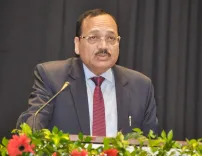Has the Last 11 Years Seen a Major Boost in India's Oil & Gas Infrastructure?

Synopsis
Key Takeaways
- Modern refineries enhance production capacity.
- Strategic petroleum reserves safeguard against emergencies.
- Expansion of PNG increases access to cleaner cooking fuels.
- CNG availability grows with 8,000 stations nationwide.
- Skill development is crucial for a skilled workforce.
New Delhi, June 12 (NationPress) Minister of Petroleum and Natural Gas, Hardeep Singh Puri, stated on Thursday that during the past 11 years, India's oil and gas sector has experienced significant growth, ranging from the construction of modern refineries and pipelines to the securing of reserves and the promotion of cleaner fuels as part of the ongoing infrastructure transformation in the nation.
The minister remarked, “Infrastructure has been pivotal to India’s growth narrative under Prime Minister Narendra Modi’s guidance, and these advancements in the oil and gas sector have fortified the nation’s energy security while establishing a foundation for future self-sufficiency.”
Highlighting key infrastructure achievements in the oil and gas domain, Puri noted that the country now boasts 23 modern operational refineries with a cumulative capacity of 257 million metric tonnes per annum, capable of producing vital petroleum products such as petrol, diesel, jet fuel, and LPG.
The Piped Natural Gas (PNG) infrastructure, supplying green cooking fuel to households, has expanded to encompass 733 districts nationwide.
Additionally, Compressed Natural Gas (CNG) is now available at 8,000 retail stations across the country for vehicle fueling.
The minister further emphasized that E20 ethanol-blended petrol is now accessible for consumers at all retail outlets across the nation.
Moreover, the Ministry's Compressed Bio-Gas (CBG) initiatives have led to the establishment of 106 plants with a combined capacity of 625 TPD.
The minister also highlighted the initiative to create storage facilities for strategic petroleum reserves, crucial for the country during emergencies and geopolitical uncertainties.
These reserves can be utilized during periods of soaring global prices to provide a buffer for national oil companies.
Storage capacity at Pudur stands at 2.25 million metric tonnes (MMT), the Visakhapatnam facility can store 1.33 MMT of crude oil, while Mangalore has a storage capacity of 1.5 MMT.
An additional strategic reserve facility is under construction at Chandikhol, located on the coastline.
He also pointed out that public sector oil marketing companies have established six skill development institutions, successfully skilling approximately 16,000 professionals to date.









